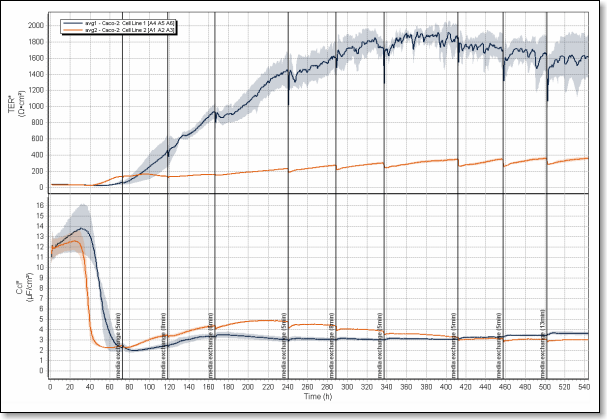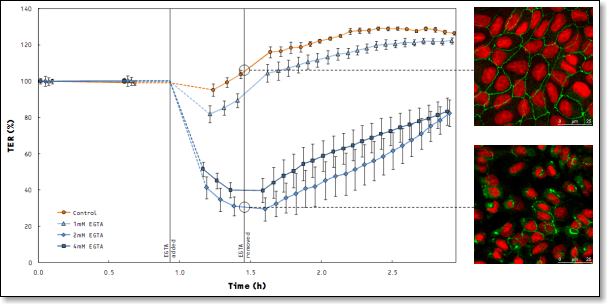Impedance Based Cell Monitoring – From Short-Term Tight Junction Dynamics To Long-Term Layer Formation
Impedance spectroscopy is the method of choice for analyzing and monitoring cell cultures under physiological conditions. It works label-free, does not require any fixation or staining, and allows to keep the cell cultures which are under investigation alive for subsequent experimental steps. These features combined with a high level of automation in data acquisition and analysis as implemented in the cellZscope® make it the ideal tool for studying epithelial or endothelial cells in vitro. The cellZscope is equally suited for following short-term dynamics in the tight junctions network as well as for long-term monitoring of cellular processes such as layer formation, differentiation, and polarization.
Tight junctions dynamics
The barrier properties of epithelial and endothelial cell layers are determined to a large extend by tight junctions located in the intercellular space. As they form a seal between the apical and basolateral membrane domain they have a strong influence on the paracellular passage of substances. The barrier function is not static but can be deliberately modulated by exposure to specific stimuli. The resulting dynamics of the tight junction network can be conveniently followed by measuring the transepithelial / -endothelial electrical resistance (TER) with the cellZscope. The figure below shows the effect of exposing Madin-Darby canine kidney (MDCK) cells grown confluent on the permeable membranes of standard cell culture inserts to different concentrations of EGTA.

It is well known that this reagent leads to a depletion of extracellular Ca2+ which in turn causes a disassembly of tight junction [1, 2]. The latter is reflected by a significant drop in the TER readings. Subsequent replacement of the EGTA containing medium by standard medium led to a regeneration of the tight junctions network as revealed by increasing TER readings. For validation of the temporary break down of the barrier function two cell cultures were fixed just before removal of EGTA. Samples were then stained for immunofluorescent analysis of cell nuclei and ZO-1 proteins. Imaging by Confocal Laser Scanning Microscopy and comparison with the untreated reference cell culture clearly revealed the disintegration of the tight junctions network induced by EGTA exposure. These findings are in excellent agreement with the TER results and demonstrate the benefits of using a label-free and noninvasive technique as implemented in the cellZscope.
Cell layer formation
Application of impedance spectroscopy for cell analysis is not limited to short-term following of dynamic processes but also allows continuous monitoring of cell cultures for several days or even weeks. The fact that various factors such as seeding density, type of growth medium, concentration of serum, type of substrate coating and temperature have a strong influence on cell layer formation calls for a means to monitor growth continuously while maintaining physiological conditions. Both readout parameters of the cellZscope, the transepithelial / -endothelial electric resistance (TER) and the cell layers’ capacity (Ccl) provide valuable information about the current state of cells as they grow confluent and differentiate. Caco-2 is a well-established cell line derived from human colon adenocarcinoma which is commonly used for drug-transport studies. Precise knowledge of the cell layer’s growth state is mandatory for use as an intestinal permeability model. In the experiment depicted below the cellZscope was employed to follow layer formation and differentiation of Caco-2 cells, with automated data recording beginning right after seeding and continuing for a total time span of more than three weeks.

Except for media exchange at regular time intervals no manual intervention was necessary for recording the data. Thus optimal physiological conditions were maintained throughout the experiment. The full time course reveals distinct differences in the growth behavior of the two different Caco- 2 cell lines. Hence, the cellZscope provides quality control for cell layers and allows to have well-defined starting conditions for subsequent experiments such as permeability studies.
nanoAnalytics thanks K. Hardes, V. Heitmann, J. Hüwe, M. Kahns, K. Riehemann
(Westfälische Wilhelms-Universität Münster) for their comprehensive support.
[1] Rutten, M.J., Hoover, R.L., Karnovsky, M.J., Electrical resistance and
macromolecular permeability of brain endothelial monolayer cultures, Brain Res. 425, 301 (1987).
[2] Rothen-Rutishauser, B., Riesen, F.K., Braun, A., Günthert, M., Wunderli-Allenspach,
H., Dynamics of Tight and Adherens Junctions Under EGTA Treatment. J. Mem. Biol. 188, 151 (2002).